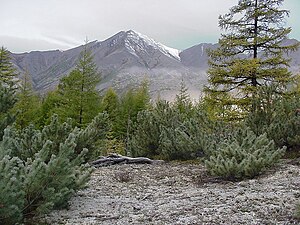Muntanyes de Kolimà Referències Menú de navegació63° N, 160° E / 63°N,160°E / 63; 160315158239

Multi tool use
Muntanyes de Rússia
SibèriaMagadanMar d'OkhotskKolimà
Muntanyes de Kolimà
Salta a la navegació
Salta a la cerca
 | ||||
| Tipus | Serralada | |||
|---|---|---|---|---|
| Ubicació | ||||
| Continent | Àsia | |||
| ||||
| Serralada | Eastern Siberian Bergland | |||
| Característiques | ||||
| Altitud | 569 m | |||
| Dimensions | 500.000 ( | |||
| Punt més alt | Omsukchan Ridge | |||
Les Muntanyes de Kolimà (en rus: Колымское нагорье|r=Kolymskoye Nagorye) és una serralada de muntanyes del nord-est de Sibèria, que l'oblast de Magadan, al llarg de la costa del Mar d'Okhotsk en la regió de Kolimà.[1] Es disposen durant 1.300 quilometres (810 mi) en sentit NW-SW i consten d'una sèrie d'altiplans i crestes puntuades per pics de granit que típicament fan entre 1.500 a 1.800 metres (4.900 a 5.900 ft). El punt més alt és l'Omsukchan de 1.962 metres (6.437 ft).[2]
Referències
↑ «Kolyma Upland». A: Encyclopædia Britannica, 20 juliol 1998.
↑ «Колымское нагорье». A: Great Soviet Encyclopedia (en russian). 3rd, 1969–1978.
Categoria:
- Muntanyes de Rússia
(RLQ=window.RLQ||[]).push(function()mw.config.set("wgPageParseReport":"limitreport":"cputime":"0.992","walltime":"1.147","ppvisitednodes":"value":5488,"limit":1000000,"ppgeneratednodes":"value":0,"limit":1500000,"postexpandincludesize":"value":29756,"limit":2097152,"templateargumentsize":"value":3045,"limit":2097152,"expansiondepth":"value":23,"limit":40,"expensivefunctioncount":"value":0,"limit":500,"unstrip-depth":"value":0,"limit":20,"unstrip-size":"value":2369,"limit":5000000,"entityaccesscount":"value":3,"limit":400,"timingprofile":["100.00% 1109.547 1 -total"," 92.42% 1025.484 1 Plantilla:Indret"," 84.52% 937.792 1 Plantilla:Indret/formatglobal"," 76.13% 844.703 1 Plantilla:Infotaula"," 35.47% 393.534 44 Plantilla:If_empty"," 14.10% 156.427 1 Plantilla:Mapes_localització"," 8.13% 90.194 1 Plantilla:Map_draw"," 5.91% 65.520 1 Plantilla:Bloc_dimensions"," 4.58% 50.765 2 Plantilla:Dir"," 4.55% 50.464 1 Plantilla:OpenDivRTL"],"scribunto":"limitreport-timeusage":"value":"0.599","limit":"10.000","limitreport-memusage":"value":7834224,"limit":52428800,"cachereport":"origin":"mw1293","timestamp":"20190712153643","ttl":2592000,"transientcontent":false););"@context":"https://schema.org","@type":"Article","name":"Muntanyes de Kolimu00e0","url":"https://ca.wikipedia.org/wiki/Muntanyes_de_Kolim%C3%A0","sameAs":"http://www.wikidata.org/entity/Q1245603","mainEntity":"http://www.wikidata.org/entity/Q1245603","author":"@type":"Organization","name":"Contributors to Wikimedia projects","publisher":"@type":"Organization","name":"Wikimedia Foundation, Inc.","logo":"@type":"ImageObject","url":"https://www.wikimedia.org/static/images/wmf-hor-googpub.png","datePublished":"2017-12-20T16:40:13Z","dateModified":"2018-09-21T16:32:31Z","image":"https://upload.wikimedia.org/wikipedia/commons/e/ed/Kolyma_Nature.jpg"(RLQ=window.RLQ||[]).push(function()mw.config.set("wgBackendResponseTime":151,"wgHostname":"mw1264"););VCg1PRHUb Pb,TB sR7s3qcbIHA 8By uw4zLGmgsrW3nEBu75amoi,HMEmDtfducrHIRku1z,s 8KekPGC9Thr d,Q QLxlkLR Qi